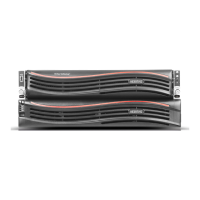During the initial stage of an iSCSI session, the appliance (initiator) sends a login
request to the storage system to begin an iSCSI session. The storage system will
then either permit or deny the login request, or determine that a login is not required.
If authentication is enabled on the target, the credentials must be authenticated
and the session established before the server can access the storage resources.
The server compares the value from the client and, if the information matches,
grants the session. If the response fails, the session is denied, and the request
phase starts over.
The initiator logs in using a CHAP user name and password. You can specify a
CHAP password or generate a random password. To set up and configure CHAP
authentication, see the target vendor documentation.
Discovering targets by using the portal address
This section provides instructions for discovering iSCSI targets by using the target
portal address. The target portal address is the hostname or IPv4 address that is
associated with the target.
The format of the target portal address is <IPv4 Address/hostname>:[<port>].
Example: 192.116.116.50 or abc:3260 where 3260 is the default port.
You must first discover a target in order to connect to it.
To discover a target by using the target portal address
1
Open a Secure Shell (SSH) session to log on to the appliance as an
administrator.
2
Navigate to the Main_Menu > Settings > iSCSI menu.
3
Type the command Target Discover Portal
4
Enter the target portal address and the iSCSI interface name that you have
configured as parameters. Note the following considerations:
■ The target portal address must be of the following format: <IPv4
address/hostname>[:port]. The host name can be a short name or a fully
qualified domain name.
Example: 192.116.116.50 or abc:3260
26Configuring iSCSI
Discovering targets by using the portal address

